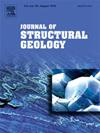意大利亚平宁南部中生代浅水碳酸盐岩溶液表面孔隙空间特征及渗透率
IF 2.9
2区 地球科学
Q2 GEOSCIENCES, MULTIDISCIPLINARY
引用次数: 0
摘要
以意大利亚平宁山脉南部的Viggiano山和Raparo山的中生代和始新世碳酸盐样品为研究对象,研究了溶液表面对现今孔隙度和渗透率的影响。碳酸盐岩岩相包括泥岩、砾岩、颗粒岩和原岩,气体孔隙度测量显示有效孔隙度可达5%。这主要是由于次生孔隙度主要分布在微裂缝及粗糙层-平行层和粗糙层-斜层溶液表面,而非光滑层-平行层,说明粗糙度对孔隙的局部化具有控制作用。核磁共振(NMR)结果表明,前一类溶液表面包括亚球形到管状的孔洞(孔喉r <;3 μm),低纵横比(r <;2)形成对压缩敏感性低的孔隙。微裂缝形成毛细管孔隙(r≈1 μm),具有高纵横比(r >;2)典型的对压缩敏感的孔隙。室温下的渗透率测量结果表明,含有可见微裂缝的样品的渗透率值比只有可见溶液表面的样品高2个数量级,表明孔隙连通性是由开孔模式、亚毫米尺度的微裂缝控制的。当围压大于25 MPa时,以裂缝和茎杆岩为主的样品的渗透率值相似,这表明在深度大于约1 km时,粗粗的茎杆岩局部存在有效孔隙度,这可能会增强碳酸盐岩中沿溶液表面流体的流动。本文章由计算机程序翻译,如有差异,请以英文原文为准。
Pore space properties and permeability of solution surfaces in Mesozoic shallow-water carbonates, southern Apennines, Italy
Focusing on the Mesozoic and Eocene carbonate samples from the Viggiano Mt. and Raparo Mt., Southern Apennines of Italy, we examine the role of solution surfaces on the present-day porosity and permeability. Carbonate lithofacies include mudstones, packstones, grainstones, and rudstones and gas-porosimetry measurements show effective porosity up to 5 %. The value is mainly due to the secondary porosity localized along microfractures and within the rough bed-parallel and rough bed-oblique solution surfaces, contrary to what was found in the smooth bed-parallel ones, showing that roughness can control pore localization. NMR (Nuclear Magnetic Resonance) results indicate that the former group of solution surfaces include vugs characterized by subspherical to tubular shapes (pore throat r < 3 μm), and low aspect ratios (r < 2), forming pores with low sensitivity to compression. The microfractures form capillary porosity (r ≈ 1 μm) and are characterized by high aspect ratios (r > 2), typical of pores with high sensitivity to compression. Permeability measurements at room pressure reveal that samples with visible microfractures are characterized by values up 2 order magnitude greater than of those with only visible solution surfaces, showing that the pore connectivity is controlled by opening-mode, sub-mm scale microfractures. At confining pressures greater than 25 MPa, both fracture- and stylolite dominated samples show similar values of permeability, indicating that at depths larger than ca. 1 km, the rough stylolite localize effective porosity that may enhance the along-solution surface fluid flow in carbonates.
求助全文
通过发布文献求助,成功后即可免费获取论文全文。
去求助
来源期刊

Journal of Structural Geology
地学-地球科学综合
CiteScore
6.00
自引率
19.40%
发文量
192
审稿时长
15.7 weeks
期刊介绍:
The Journal of Structural Geology publishes process-oriented investigations about structural geology using appropriate combinations of analog and digital field data, seismic reflection data, satellite-derived data, geometric analysis, kinematic analysis, laboratory experiments, computer visualizations, and analogue or numerical modelling on all scales. Contributions are encouraged to draw perspectives from rheology, rock mechanics, geophysics,metamorphism, sedimentology, petroleum geology, economic geology, geodynamics, planetary geology, tectonics and neotectonics to provide a more powerful understanding of deformation processes and systems. Given the visual nature of the discipline, supplementary materials that portray the data and analysis in 3-D or quasi 3-D manners, including the use of videos, and/or graphical abstracts can significantly strengthen the impact of contributions.
 求助内容:
求助内容: 应助结果提醒方式:
应助结果提醒方式:


